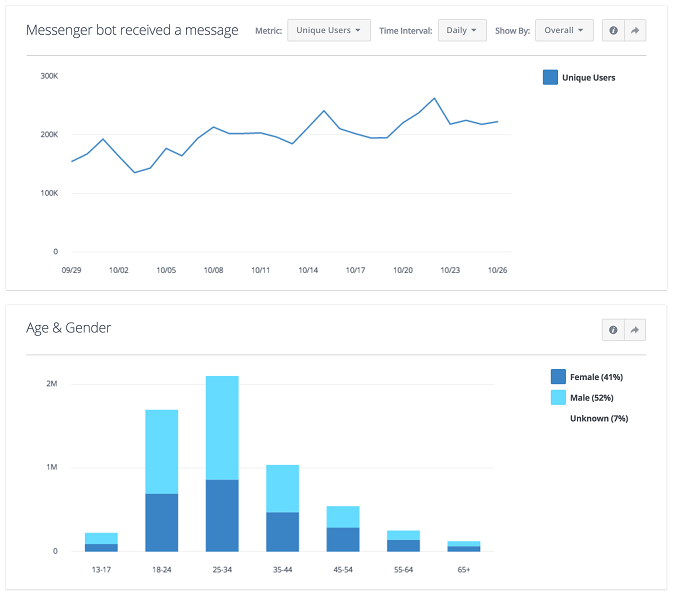Five most important search marketing news stories of the week
Welcome to our weekly round-up of all the latest news and research from the world of search marketing and beyond.
This week, both LinkedIn and Facebook are beefing up their paid social offerings in different ways, while Google seeks to cut off Adwords revenues for fake news sites. And might Google be favouring desktop over its own AMP in its upcoming mobile-first index?
Facebook launches analytics for Messenger chatbots
On Monday, Facebook announced that it will be extending its Facebook Analytics for Apps tool to Messenger, so that early adopters of chatbots will be able to track the response to them via analytics.
Al Roberts reported for Search Engine Watch’s sister site, ClickZ, that brands who have built chatbots using Facebook’s Messenger Platform will have access to a variety of metrics without needing to add additional code. These will include messages sent, messages received, user blocks and unblocks.
Roberts considered whether analytics could be the key to the success of chatbots by allowing brands to see exactly where their interactions with users are falling short.
LinkedIn Sponsored InMail goes self-serve
LinkedIn Sponsored InMail, which allows marketers to send promotional messages to the InMail inboxes of LinkedIn users, has been opened up to self-service advertising campaigns.
Brands who wanted to use Sponsored InMail to advertise were previously required to go through a LinkedIn Account Representative. But as of last week, they can do it all themselves through the LinkedIn Campaign manager.
Al Roberts reported on ClickZ that,
“Marketers can target their Sponsored InMail messages by filters such as location, company, industry, title, skills and education, and to set a call-to-action that is displayed prominently in the message.
LinkedIn handles all of the formatting to ensure that Sponsored InMail messages look good on desktop and mobile, and provides marketers with a variety of analytics data, such as opens and clicks. The popular professional social network also offers marketers the ability to A/B test variations of their content.”
Mobile advertising accounts for nearly half of digital ad spend—but what does that mean for fraud?
Search Engine Watch’s resident mobile expert Andy Favell reported this week that mobile advertising now accounts for nearly half of digital ad spend—but it comes at a price. Favell takes an in-depth look at the phenomenon of mobile ad fraud, including how it works, how widespread it really is, and why it’s currently on the rise.
Google prevents fake news sites from serving ads through AdSense
In the wake of the US presidential election, a lot of attention has been drawn to the issue of fake news on websites like Facebook and Google, and the role that they might have played in spreading misinformation prior to the vote. Search Engine Journal reported on Tuesday that Google has taken concrete action around the problem by preventing fake news sites from serving ads through AdSense.
Google’s official documentation now states:
“Users don’t want to be misled by the content they engage with online. For this reason, Google ads may not be placed on pages that misrepresent, misstate, or conceal information about you, your content or the primary purpose of your web property.”
While the changes won’t prevent fake news sites from showing up in search results, it does cut off a source of the ad revenue that the websites rely on to make money. Facebook took similar steps this week by updating its advertising guidelines to exclude fake news sites from generating revenue from Facebook Audience Network, after it was revealed that “fakebait” sites were bringing in tens of thousands of dollars in ad revenue through Facebook.
Google’s mobile-first index opts for desktop over AMP… we think
One of the biggest upcoming changes to search in the next few months will undoubtedly be Google splitting its index between mobile and desktop. SEOs have been gearing up for the change ever since Google announced it in October, but there has been some confusion over how Google will treat sites which have an Accelerated Mobile Pages, or AMP, version versus a regular mobile site.
This week, The SEM Post covered a surprising revelation: when a site has a desktop version and an AMP version with no other mobile version of the site, Google will index the desktop version.
For its mobile-first index.
So @maileohye confirmed that in a situation where there is desktop and AMP, Google will index desktop for mobile first. #StateofSearch
— Jennifer Slegg (@jenstar) November 14, 2016
This information appeared to contradict a previous tweet by Google’s Gary Illyes, who had said that AMP would be evaluated for organic in the new index model:
@AlanBleiweiss AMP is mobile friendly, so amp
— Gary Illyes (@methode) November 13, 2016
Barry Schwartz of Search Engine Roundtable went back to Illyes to confirm the new information, and Illyes clarified:
@rustybrick @maileohye @AlanBleiweiss yeah. I should've said that if you make the amps your pages' mobile version, then amps would be picked
— Gary Illyes (@methode) November 16, 2016
@rustybrick @maileohye @AlanBleiweiss but with the default amp setup desktop is picked. I dunno of any site that has only desktop+amp tho
— Gary Illyes (@methode) November 16, 2016
So yes, that clears things up 100% with no ambiguity whatsoever. If you have an AMP version of your site (but no other mobile version) and make it the mobile version of your site, mobile-first will index AMP, but with the default setup, mobile-first will index desktop.
But if you have only AMP with no other version of your site (including desktop), per Slegg’s original article, then the mobile-first index will index AMP. And presumably so will the desktop index, as there isn’t any other version of the site to index.
Got it.
source https://searchenginewatch.com/2016/11/18/five-most-important-search-marketing-news-stories-of-the-week-12/

